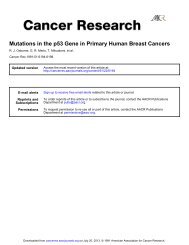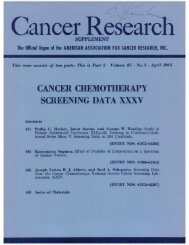XANTHOMA OF THE BREAST In a series of nine hundred (circa ...
XANTHOMA OF THE BREAST In a series of nine hundred (circa ...
XANTHOMA OF THE BREAST In a series of nine hundred (circa ...
You also want an ePaper? Increase the reach of your titles
YUMPU automatically turns print PDFs into web optimized ePapers that Google loves.
Downloaded from cancerres.aacrjournals.org on December 28, 2013. © 1932<br />
American Association for Cancer Research.<br />
1078 CUSHMAN D. HAAGENSEN<br />
would be facilitated by a brief survey and classification <strong>of</strong> the types<br />
<strong>of</strong> xanthoma in general. A division into two broad groups on the<br />
basis <strong>of</strong> whether the tumor is a primary xanthoma, made up wholly<br />
<strong>of</strong> xanthoma cells, arising as a local manifestation <strong>of</strong> the syndrome<br />
<strong>of</strong> xanthomatosis, or a secondary degenerative process in an inflammatory<br />
or neoplastic lesion, would seem to be the simplest classification.<br />
Such a classification closely follows those proposed by<br />
Siemens and by Asch<strong>of</strong>f. The terminology follows:<br />
A. Primary Xanthoma (Simple hematogenous cholesterosis, Sie<br />
. mens; Xanthoma, Asch<strong>of</strong>f): A tumor composed wholly <strong>of</strong><br />
xanthoma cells, and arising as a local manifestation <strong>of</strong> the<br />
syndrome <strong>of</strong> xanthomatosis.<br />
B. Secondary Xanthomatous Degeneration in (1) neoplasms and (2)<br />
inflammatory processes (<strong>In</strong>flammatory-degenerative cholesterosis,<br />
Siemens; Pseudoxanthoma, Asch<strong>of</strong>f).<br />
A. PRIMARY <strong>XANTHOMA</strong><br />
Most <strong>of</strong> the types <strong>of</strong> xanthoma can be grouped as subvarieties <strong>of</strong><br />
the syndrome <strong>of</strong> xanthomatosis. They will have in common a<br />
proved etiology <strong>of</strong> disturbed lipoid metabolism. They will have,<br />
also, a common histologic structure, the unit in which is the<br />
characteristic xanthoma or foam cell. This is a very large cell,<br />
measuring usually between 30 and 50 microns in diameter. It is<br />
<strong>of</strong>ten round but adapts its shape to the interstices in the connectivetissue<br />
stroma in which it lies. The nucleus is very small and round.<br />
The cytoplasm, which makes up most <strong>of</strong> the cell, stains lightly.<br />
Under high power its foamy appearance is seen to be due to a fine<br />
network in which droplets <strong>of</strong> cholesterin esters are contained.<br />
These tumors present no evidence <strong>of</strong> inflammatory origin in the<br />
form <strong>of</strong> lymphocytic, polynuclear or plasma-cell infiltration.<br />
They are not associated with other varieties <strong>of</strong> neoplasms. They<br />
contain occasional giant cells, which usually lie in the vicinity <strong>of</strong><br />
the crystals <strong>of</strong> cholesterin esters which are scattered throughout<br />
the tumor. These crystals, as well as the intracellular droplets,<br />
when studied in unstained sections after fixation in formalin, are<br />
doubly refractive to polarized light. The subvarieties <strong>of</strong> xanthoma<br />
included in this primary syndrome <strong>of</strong> xanthomatosis are as follows:<br />
(1) Xanthoma palpebrarum: This is the most frequent type <strong>of</strong><br />
xanthoma. It has been recognized and described by dermatologists<br />
for over a century. The characteristic plaques and nodules,
















